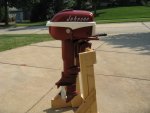Re: i386 Boat Restoration. (Crosby Sled)
Concerning i386's point about cutting the deck to minimize resin and filler... The process i'd suggest is "spiling". Basically, Spiling is no more than transferring curvature or awkward angle to templates using fixed planes.
To start you cobble together
two rough copies (top and bottom) of the surface you want to deck. (See:
http://sendthemnorth.blogspot.com/2008/09/patterns-and-spiling.html)
Once you have the rough copy, you can use a compass to transfer the curvature of the actual hull to the copy and then cut the copy to the exact shape of the hull... Be sure to test fit, and be sure to use a consistent longitudinal line for reference!
So why two spilings? The first spiling will be made of thin cardboard (I use opened and flat 30 pack boxes) and will represent the underside of the deck panel. The second spiling will be made of scrap that has the same thickness as your deck to be. Again, keep a close eye on that reference line and use whatever means to make the spiling stay in place while you're drawing with the compass level with the scrap.
Once you're done with the steps above you should have two copies of the outline of the deck. One for the top surface of the deck panel, and one for the bottom surface of the deck panel. These are no more than templates.
Now that you're sure that you've got everything hunky dory (reference lines etc.) cut out your deck piece to the "larger" of the two templates.
Finally, using your reference line, place the smaller template (typically the cardboard unless you're dealing with a torpedo hull) on the underside of your freshly-cut deck material and mark - that's the line you'll need to cut/sand/grind to in order to bevel the deck to fit.
Notes:
*
Ideally, you can just do the port side because the two sides
should be mirror images.
* Always keep the compass at 90 degrees to the surface being scribed.
* Don't worry if you're off a little... Epoxy likes small gaps! In the pic below, I probably cut this one a little too close when I scribed the coaming into the "arrowhead".
* Spiling is like riding a bicycle... Once you "get it" it's fast and fun - almost second nature. But until then, it's misery. In other words... Practice, practice, practice! Practice cutting a piece of wood to fit a wine glass. Practice on any curved surface. But practice before the "Big Cut".
All that being said, I know I've completely mangled the description of spiling. (Trying to explain spiling by typed word is like trying to explain balance on a bicycle.) Google is a good thing.
Anyway, I hope this helps a little...
Alan
























